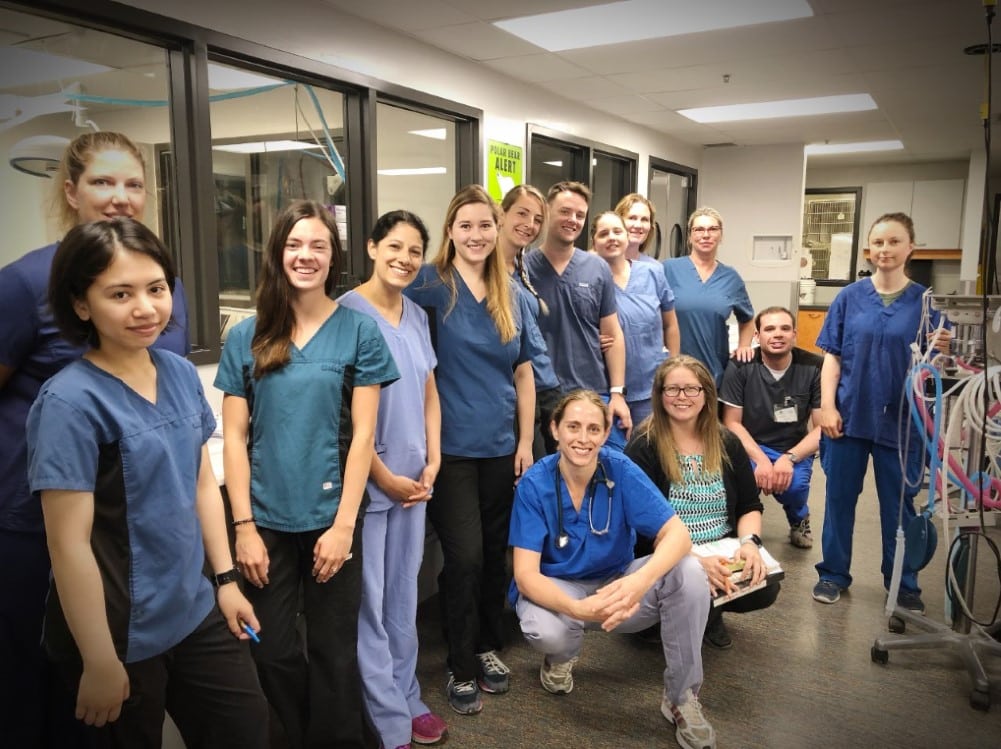
CEO Blog: Undercover Boss (not really) Series - Episode 3: Clinic

“If you feel your legs getting wobbly or start to faint, just close your eyes for a moment”
Welcome to the WHS clinic.
Our clinic is a place of hope; and also a place that is not for the faint of heart. With over 30 spay/neuter surgeries done daily, plus dental surgeries, amputations and other life-saving procedures, you need to be okay with the sight of blood, bones and teeth. Our clinic saves thousands of pets which come to us suffering from illness, hit by a car, or being rescued from abuse.
The WHS clinic not only works with surrendered animals, it also provides spay/neuter services to individuals who qualify for our low-cost initiatives. The program is an initiative generously supported by the City of Winnipeg, mostly through its cat licensing program. We also provide support for animal rescues who trust their adoptables to us, as well as remote clinics in which our team travels to different parts of Manitoba to provide spay and neuter surgeries and vaccination clinics where the need is highest.
I arrived at 8 am ready to receive animals. That morning the reception area was managed by Megan and Becca; both truly wonderful, friendly and ready to answer all the questions our clients had. Pets are entered in our system, the human caregiver signs off the surgical waiver (pets, like humans in surgery, need to be fully sedated and there are always risks), and then we place each pet in our surgery ward where they wait for their turn and where they recover. Pets are dropped off either the evening before or early in the morning, and they are picked up in the evening.
At 9 am, the entire clinic team participates in a “huddle” where news is shared and the group reviews the surgeries ahead, and anything else that may need their attention. The meeting is led by our highly organized Manager of the Clinic, Vicky Farmer and our kind and caring Director of Veterinary Services, Dr. Gina Bowen.
When she is not working at our clinic, Dr. Bowen is volunteering with rescues doing spay/neuter surgeries in remote areas of Manitoba, and on top of that she participates in meetings and strategic planning for the WHS. We are lucky to have both leaders among us.
Right after the huddle, the clinic starts to get down to business: first we start with dogs spays, then dog neuters, then cat spays and last but not least cat neuters. The best way to describe the process and how well the team works is to imagine watching a symphony orchestra perform: every person knows exactly what to do, when to do it, and how. Pets are first sedated, then shaved and intubated. Once we are happy with their heart rate and breathing, they are moved to the surgery room where one of our veterinarians will perform the surgery. Right after the surgery is done, the pet is carefully moved to another table where we clip their nails if needed and we ink a tattoo in the ear for identification purposes. Then the pet is monitored until they start waking up, and at that time the breathing tube is removed and they are placed in a recovery kennel and monitored to make sure they wake up happy and there are no signs of pain. The entire process is done in less than 15 minutes. Simply amazing!
Not only does the team perform 30 to 35 spay/neuters daily, there are also emergencies coming through the Investigation and Emergency Response team, which means having a Registered Veterinary Technician or a Veterinarian examine the injured or sick pet and establishing next steps.
One of our veterinarians, Dr. Alex Johnson, was explaining dental procedures to me when all of the sudden asked: “Hey, Javier…would you like to be my assistant?”.
“Sure”, I replied with some trepidation. And so I got my surgical gloves on, and went to the dental room with Dr. Alex. The cat we worked on had a broken canine and the pulp of the teeth was exposed. That caused pain, but can also lead to infection, which could become very dangerous for the well-being of the cat. My job was to hold the lip of the cat up, very gently, while Dr. Alex extracted the tooth. She uses a scalpel to cut around the gum, then a tool that looks like a modified screwdriver to get to the bone and then gently take the broken tooth out. After that is completed, she pulls the gum tissue and stitches up the area. This entire process takes less than 10 minutes.
Once all the spay/neuters are done, and dental surgeries are completed, and emergencies are taken care of, more complex procedures are next. We had a cat with a very painful fracture which required a leg amputation, and Dr. Gina showed me the x-rays and how she was going to go about it to ensure the cat will be able to fully recover and be placed in adoptions.
Thanks to YOUR support, the WHS clinic has an x-ray machine, we can do urine analysis and blood analysis, and our dental room is nicely equipped. We simply could not save so many lives and do so much good without the amazing support of our donors. Being at the clinic was a great reminder of how much we depend on our donors to save lives. We also have volunteers who help with nail clipping and preparing syringes to be used by the staff. It was another good reminder that you can do a lot more than just walk a dog or play with a cat as a volunteer: every area of our shelter needs and benefits from our amazing volunteers!
Even when surgeries are completed, and the operating rooms are cleaned, there is plenty more to do. The clinic staff is also responsible for checking on our pets waiting in the holding areas (strays or recovering from various illnesses), doing checkups with foster pets, and looking into any potential issues with pets in the adoption area, if our adoption team has any worries about health issues.
When it was time for me to go back to my work, looking at financial statements, going over legal matters and writing blogs, it was tough not to feel a bit useless compared to the work I just witnessed.
Everyone at the WHS clinic, from the reception team to our clinic assistants to our technicians and veterinarians have such a passion for what they do, a commitment to every animal they care for, and a determination to work as hard as they can to save as many lives as possible.
Not only I learned a lot about animal health and was able to assist with a dental surgery, most importantly I had the honour of hanging out with an inspiring, committed and fun group of people. Be sure to check out the other episodes in this series, I’ve already visited the Intake and Foster Departments and Investigations/Emergency Response.
In service,
Javier Schwersensky
WHS CEO

